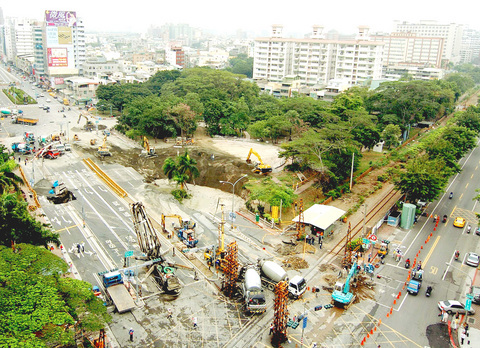Massive subsidence resulting from water seepage at a Kaohsiung rapid transit construction site snarled up traffic yesterday.
The sinkage occured at the intersection of Chungcheng Road and Tashun Road in Kaohsiung City. The subsidence resulted from the construction of a reservoir well in the area, which suddenly experienced massive water seepage on Sunday night.
The area of the subsidence increased through the morning yesterday, and it took staff from the Kaohsiung Rapid Transit Corp (KRTC) 11 hours to contain the situation.

PHOTO: HUANG CHI-YUAN, TAIPEI TIMES
Yesterday morning, 200 KRTC staff were on the scene of the collapse, and as of yesterday evening an estimated 2,800m3 of earth and concrete had been poured to shore up the damage. In addition, efforts were made to strengthen the surrounding area to prevent an expansion of the problem.
As roads had to be closed during efforts to fill the 50m by 30m crater, which was approximately 10m deep, Kaohsiung's morning rush hour traffic was severely disrupted.
To make matters worse, service on the nearby Linkang railway line was suspended for safety reasons.
According to KRTC general manager Fan Chen-po (
He said that it did not seem to be the result of human error, and that reconstruction efforts could cost up to NT$500 million (US$15 million).
Fan said that the necessary assessments had been made and that the reservoir was protected by metal boards, but these had been unable to withstand the pressure of the water which flooded the worksite.
Yesterday's accident was the latest for the Kaohsiung MRT project, following a series of construction mishaps that bedeviled the project.
Last November, a Thai worker was killed and another injured in an accident at a construction site for Kaohsiung's MRT project.
Last August, another mishap at the construction site for Shitzuwan Station on the MRT's Orange Line affected an area of 500m2 and led to the evacuation of at least 24 residents from nearby homes.
Another accident also occurred last May after drilling, which resulted in a surge of water and sand rising to the surface.
As a result, the Yancheng MRT station and surrounding structures sank 20cm, leading to the evacuation of more than 100 people from buildings nearby.

LIMITS: While China increases military pressure on Taiwan and expands its use of cognitive warfare, it is unwilling to target tech supply chains, the report said US and Taiwan military officials have warned that the Chinese People’s Liberation Army (PLA) could implement a blockade within “a matter of hours” and need only “minimal conversion time” prior to an attack on Taiwan, a report released on Tuesday by the US Senate’s China Economic and Security Review Commission said. “While there is no indication that China is planning an imminent attack, the United States and its allies and partners can no longer assume that a Taiwan contingency is a distant possibility for which they would have ample time to prepare,” it said. The commission made the comments in its annual

DETERMINATION: Beijing’s actions toward Tokyo have drawn international attention, but would likely bolster regional coordination and defense networks, the report said Japanese Prime Minister Sanae Takaichi’s administration is likely to prioritize security reforms and deterrence in the face of recent “hybrid” threats from China, the National Security Bureau (NSB) said. The bureau made the assessment in a written report to the Legislative Yuan ahead of an oral report and questions-and-answers session at the legislature’s Foreign Affairs and National Defense Committee tomorrow. The key points of Japan’s security reforms would be to reinforce security cooperation with the US, including enhancing defense deployment in the first island chain, pushing forward the integrated command and operations of the Japan Self-Defense Forces and US Forces Japan, as

‘TROUBLEMAKER’: Most countries believe that it is China — rather than Taiwan — that is undermining regional peace and stability with its coercive tactics, the president said China should restrain itself and refrain from being a troublemaker that sabotages peace and stability in the Indo-Pacific region, President William Lai (賴清德) said yesterday. Lai made the remarks after China Coast Guard vessels sailed into disputed waters off the Senkaku Islands — known as the Diaoyutai Islands (釣魚台) in Taiwan — following a remark Japanese Prime Minister Sanae Takaichi made regarding Taiwan. Takaichi during a parliamentary session on Nov. 7 said that a “Taiwan contingency” involving a Chinese naval blockade could qualify as a “survival-threatening situation” for Japan, and trigger Tokyo’s deployment of its military for defense. Asked about the escalating tensions

The Ministry of Economic Affairs said it plans to revise the export control list for strategic high-tech products by adding 18 items under three categories — advanced 3D printing equipment, advanced semiconductor equipment and quantum computers — which would require local manufacturers to obtain licenses for their export. The ministry’s announcement yesterday came as the International Trade Administration issued a 60-day preview period for planned revisions to the Export Control List for Dual Use Items and Technology (軍商兩用貨品及技術出口管制清單) and the Common Military List (一般軍用貨品清單), which fall under regulations governing export destinations for strategic high-tech commodities and specific strategic high-tech commodities. The